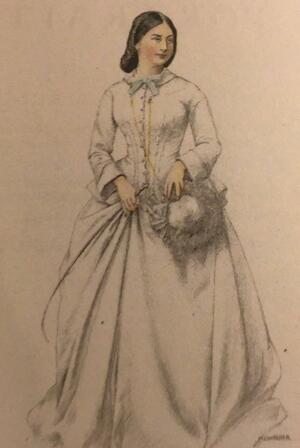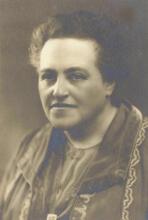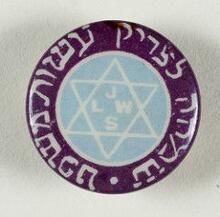Kate Magnus
Kate Emanuel Magnus’s life shows how the granddaughter of a Jewish German immigrant to England rose to the peerage and became one of the most influential figures in Jewish education in Victorian Britain. Partially, her success as a writer was due to her own talent and ambition, as she had begun composing stories before her marriage. Partially it was due to her social position, though some of her works were published before she became a peeress. She is best remembered for her Outlines of Jewish History (1885); though very popular in its day, its language is dated and a lack of scholarly references makes it less than helpful. And while she represents the ability of some to cross class lines, she nonetheless remained a traditionalist.
Overview
Kate Emanuel Magnus, Lady Magnus, was an Englishwoman best known as the author of several studies of Jewish history. She is chiefly remembered for Outlines of Jewish History, first published in 1885, which was reissued numerous times and brought up-to-date in the 1940s and 1950s to include a discussion of the modern State of Israel. The book was adopted by many religious schools in Great Britain and the United States. The Jewish Publication Society, founded in Philadelphia in 1888, chose it for its first book.
Additional chapters, on Judaism in America, were written by Henrietta Szold (the first editor at the Jewish Publication Society) and Cyrus Adler. In her original chapters, Lady Magnus uses a tone both proud and mournful, glorifying the accomplishments of the Jewish people while noting their many struggles. Since it covers in great detail thousands of years of history and thought, this book provides evidence of Lady Magnus’s wide reading.
Early Life and Family Background
Kate Emanuel’s family originated in Germany. Her grandfather, Moses Emanuel, was born there in 1759 and emigrated to England. He was a small merchant and goldsmith, but by the time of Kate’s birth in 1844, the Emanuel family was well established in Portsmouth. Her father, Emanuel Emanuel, was elected to the city council in 1841 and became mayor in 1866. Portsmouth had a busy and significant Jewish community, and its synagogue was a significant place in the life of the Emanuel family. After being educated at home—typical for families of her socio-economic status—Kate began teaching Sunday School at the age of seventeen. She devoted the next few years to reading and teaching, while resisting pressure to marry.
In 1870, when she was 26—older than usual for the time—Kate Emanuel married Philip Magnus, a second cousin and also the grandson of German immigrants. Significantly, Philip was an educated man, a graduate of University College in London, a teacher, and since 1866 the rabbi of the West London Synagogue. This congregation had been founded in the 1840s, following the new Reform movement that had broken from traditional Orthodoxy. In 1869 it relocated to a new and grand building designed by the architectural firm of Davis and Emanuel, the latter being Kate’s brother Barrow Emanuel.
Kate Emanuel’s marriage represents what is often seen during the Victorian and other eras: the fortunate career of a bright, ambitious woman who “married well.” Could Kate have become a successful writer had she not married Philip Magnus, or indeed remained unmarried? Possibly. Numerous single women writers flourished in England at this same time. But marriage definitely smoothed the path, and gained for Kate entrée into a comfortable social and intellectual life where she never had to be concerned with making her living as a writer. When Philip was elevated to the peerage in 1886, for his work in reforming national educational policy, Kate became a peeress, and her place and success were assured.
In 1870, after their wedding, Kate and Philip moved to London. Ultimately, Kate Emanuel was linked not only with the Magnus family, but with many other prominent Anglo-Jewish families, including the Goldsmids, the Spielmanns, the Montefiores, the Montagus, and the Sassoons. The new couple settled into the routine of well-to-do Londoners. The Magnus residences, mainly in the Gloucester Road area just north of Hyde Park, were distinguished but not showy. By 1880, a decade after the wedding, Kate had borne five children. In addition to two who died in infancy, they were Lucy Amy Magnus (1871-1964), Laurie Magnus (1872-1933), and Leonard Arthur Magnus (1879-1924).
Writing Career and Jewish Identity
In 1925, soon after Lady Magnus’s death, a special memorial edition of Jewish Portraits, one of her most celebrated books, appeared, featuring an introduction by “L.M.,” assumed to be the elder Magnus son Laurie. As he wrote, “Lady Magnus lives in her books—for Jewish readers, chiefly in her Jewish books—and readers of Lady Magnus’s books who knew the author will know how steadfastly she practised many of the virtues which she praised in the heroes of her religion…. [A]ll her life long she never omitted to spread the white cloth and light the candles in honor of Sabbath” (xi-xii). From the beginning, her life and her writing were proudly Jewish.
Possibly due to the influence of the many texts Magnus read in the 1880s when she first wrote the Outlines of Jewish History, her language is elevated and almost biblical: “the miserable glorious record of the ages, is itself, in truth, never ending. Line upon line is still being added, and finis will never be written on the page of Jewish history till the Light which shineth more and more unto the Perfect Day shall fall upon it and illumine the whole beautiful world” (Outlines, 340, 1958 edition). The stentorian tone of Kate’s writing did not make her books any less popular.
Jewish Portraits, also written in the 1880s, is a slim volume of about 240 pages, with essays on Jehudah Halévy, the Frankfurt Judengasse, Heinrich Heine, George Eliot’s Daniel Deronda, Manasseh Ben Israel, charity in Talmudic times, Moses Mendelssohn, The Story of a False Prophet (Shabbatei Zevi), and Women in Israel. Portraits was originally published as a series of essays in magazines including Good Words, Macmillan’s, National Review, and The Spectator, with an anthologized edition first published by T.Fisher Unwin in 1888. A second edition was published by Nutt in 1897, a third by Myers & Company in 1902, and yet another in 1912. And then there was the Memorial Edition in 1925.
Literary scholar Cynthia Scheinberg writes that “Magnus speaks in the easy, cultured persona of the educated upper-class Englishwoman, often using irony and sarcasm and demonstrating a detailed knowledge of Jewish literature and religion” (Scheinberg, 48-49). Here, for example, is Magnus’s discussion of the Middle Ages, where she finds Jewish culture surpassing that of the Jews’ Christian neighbors:
Whilst the leaders of society, the licentious crusader and the celibate monk, were stumbling so sorely in the shadow of the Cross, and whilst the rank and file throughout Europe were steeped in deepest gloom of densest ignorance and superstition, the lap of learning, handed down from generation to generation of despised Jews, was still being carefully trimmed, and was burning at its brightest among the little knot of philosophers and poets in Spain (from “Jehudah Halevi,” in Jewish Portraits, Bloch, 1925, pp. 6-7).
Lady Magnus’s popular children’s book Boys of the Bible (1894) also went through several editions. In this book she related stories about Isaac; Jacob and Esau; Joseph; Moses; Samuel; David and Jonathan; Joash; Daniel; and Samson. Her First Makers of England (1901) is a departure from Jewish to British history; here she writes about the contributions of Julius Caesar, King Arthur, and Alfred the Great to the formation of the modern nation. A poet as well as an essayist, Lady Magnus published two volumes of original verse, Salvage (1899) and A Book of Verse (1905).
Defender of Tradition
Kate Magnus also contributed articles about general education and English history to periodicals such as the Westminster Gazette, the National Review, and Good Words. She often showed herself to be a staunch defender of tradition. For example, in “The Higher Education of Women,” published in the Eclectic Magazine in February 1889, Magnus wrote at length about the educational opportunities offered to “this wonderful product of our nineteenth century”(p. 246), but then asks if they are truly necessary: “Is it needful, is it admirable, this hopelessly, heedfully unattractive departure from traditional womanhood?” Magnus was no New Woman. She wanted quality education for women but not necessarily gained at an institution, and to be acquired only in the interest of better suiting women to their traditional roles. She fretted that a “modern crowd of machine-made mediocrities, instructed and uneducated, which the high-school mills grind out,” would take men’s jobs at lower pay, forcing young men to go to the colonies to find work. Far better, she continued, to promote “literature rather than laboratories” and to help young women gain “some grip on the lost art of reading, as distinct from reading up”(p. 249). In this way, they would become more fit wives and mothers.
Magnus’s views did not sit well with her contemporaries who were active in women’s rights. Eva Knatchbull-Hugesson, for example, published a long rebuttal to this article in the National Review (London), writing that “Lady Magnus should really bring forward some statistical proof in support of her statements.” But as a peeress and a publicly Jewish woman, Lady Magnus must have been very conscious of the need for being non-confrontational. She could not afford to be a firebrand. Although progressive in terms of her faith—she belonged to a Reform rather than an Orthodox congregation— Kate Magnus was a traditionalist in her social beliefs. Indeed, it had been only 30 years since Jews elected to Parliament could be seated without having to take the oath of office on a Christian Bible. By mid-century, Jews had distinguished themselves in all areas of English life (education, business, government service, publishing, the military, the arts and sciences, community service) and strove to be like their neighbors except in religious observance. Numbering about 50,000, the Jews had become assimilated into the British population, and by century’s end at least a dozen had been admitted to the peerage.
In addition to being a social traditionalist, Lady Magnus was also anti-Zionist just as Zionism was beginning. Theodor Herzl, the Austro-Hungarian journalist considered one of the movement’s founders, spoke in London in 1895 and 1902. Established middle-class Jews in Britain opposed Zionism, wishing instead to emphasize the positive contributions of Jewish citizens to Britain’s overall cultural portrait. With the 1887 creation of the Anglo-Jewish Historical Exhibit and the founding in 1893 of the Jewish Historical Society of England, Jews were finally considered to have “arrived,” as all official barriers to their acceptance had been eradicated.
Yet dangerous socio-political conditions in Eastern Europe were driving hundreds of thousands to America, and to Britain if they could not afford passage to America. Poor and poorly educated Jews were aided by programs developed by assimilated, wealthier co-religionists. In a 1903 letter, Magnus stated that her anti-Zionism came from her reluctance to see the Bible lands become “a dumping ground for sad, soiled rubbish. I ache for those poor refugees—but I can’t help put them where the prophets trod— it isn’t fair to our memories nor our hopes that Zion should be repelled except by our best” (quoted in Cohen, p. 96). Historian Lloyd Gartner notes that while there was “considerable fellow-feeling” between immigrant and native Jews, relationships between them “were distant, and feelings of mutual disdain were heard from both quarters” (p. 273). Lady Magnus came down solidly on the side of her class.
Very little has been written about Lady Magnus’s personal life. One rare example is an anecdote related by Harry Furniss, an illustrator for Punch, who recalled his first meeting with Lady Magnus on a train in about 1888, and immediately after on a visit to Surrey:
This was the beginning of a very pleasurable friendship with one of the most charming households in the county. Lady Magnus wrote an account of her trip through Austrian Tyrol, “From Shadow to Sunshine,” for one of the magazines, and I illustrated it. She is an accomplished writer, but contributes to magazines as a recreation more than as a professional proposition. The money she receives for her writing she informed me she spent on knick-knacks and things of beauty (Furniss, p. 31).
She referred to one chair as Good Words, the sofa as the Fortnightly, and a picture frame with her daughter’s likeness as the Pall Mall Gazette.
“And where are the boys’ photos?” I asked. “Oh, they are in the ‘Saturday Review,’ handing me another gorgeous frame” (Furniss, p. 32).
Was this casual manner an offhand joke? If not, was Lady Magnus saying, “A trifle! I really write for fun and the occasional chair”? Or perhaps she regarded writing as other Victorian titled ladies who were willing to sing at social events or engage in amateur theatricals but would never consider professional performance. With no written record other than that of Henry Furniss, who could be very dismissive of talented women, we cannot be sure.
In terms of tzedakah, or charity, Lady Magnus was in the forefront of her community. Many Jewish-organized charities had existed in England since the 18th century, following the traditional dictates of Judaism. One result of the huge influx of immigrants to London in the 1880s and 1890s was the tremendous development of educational organizations, settlement houses, and “friendly societies.” Women of wealth took up the cause and were heavily involved. Lily Montagu’s West Central Girls’ Club and The Jewish Working Girls’ Club, founded in 1866 and also called “Lady Magnus’s,”were two of the many organizations that offered a large program of classes and activities. Laurie Magnus quotes a letter from a woman recalling her experience at the club many years before :
Lady Magnus was to me always an example of the happiness that can be conferred by the bestowal of "small" kindnesses—the loan of her carriage to take an old friend for an airing, the invitation to an ardent young spirit to accompany her to a concert or picture exhibition, the invitation to a week-end visit, her Saturday afternoon teas for her Club girls, who were made to feel themselves quite at home among her own circle of friends. The memory of her youthful and happy spirit is always with me, and the inspiration of her selfless work and love of humanity has been an abiding possession and incentive (Jewish Portraits, Memorial Édition, XIV).
Legacy
Lady Magnus stayed active as a writer through the first decade of the new century, publishing her book on the Makers of England, as well as the volume of her poetry. The Jewish Encyclopedia of 1906 lists about 300 individuals in Britain who, from 1700 on, distinguished themselves in service, the arts and sciences, government, finance, and education. Among these are fifteen women writers, but the only names immediately recognizable today are those of Grace Aguilar and Amy Levy—and Kate Emanuel, Lady Magnus.
Kate Emanuel Magnus died of influenza in 1924 at the age of 80 and was buried in the Jewish cemetery in northern London. Its chapel, like the West London Synagogue, was designed by her brother Barrow Emanuel’s firm in 1896. Sir Philip Magnus died in 1933, and he endowed the “Lady Magnus Memorial Lecture” to be given annually by the Jewish Historical Society of England. The name of Lady Magnus and her publications were highly visible. She and Sir Philip raised the profile of the Jewish people as valued contributors to English life. Today their great-grandson, Sir Laurie Magnus, the 3rd Baronet Magnus of Tangley Hall, is chairman of Historic England.
Cohen, Stuart. English Zionists and British Jews: The Communal Politics of Anglo-Jewry. Princeton: Princeton University Press, 1982.
Foden, Frank. Philip Magnus, Victorian Educational Pioneer. London: Valentine, Mitchell, 1970.
Furniss, Harry. Some Victorian Women. New York: Dodd, Mead, 1923.
Galchinsky, Michael. The Origin of the Modern Jewish Woman Writer. Detroit: Wayne State University Press, 1996.
Gartner, Lloyd P. The Jewish Immigrant in England. Detroit: Wayne State University Press, 1960.
Harris, Isidore, Ed. The Jewish Year Book 5663. London: Greenberg & Company, 1902.
Jacobs, Joseph. “London,” Jewish Encyclopedia, 1906.
Knatchbull-Hugeson, Eva. “A Rebuttal,” National Review, XIII, 1889: 33-34
Lipman, V. D. Three Centuries of Anglo-Jewish History. Durham, NC: Duke University Press, 1961.
The Literary Year-Book 1908. London: Routledge, 1908.
Magnus, Laurie. Introduction to Jewish Portraits, Memorial Edition. New York: Bloch, 1925.
Publishers’ Circular & Booksellers’ Record of British & Foreign Literature, LXX, Jan-June, 1899.
Roth, Cecil. “The Portsmouth Community and its Historical Background.” In Journal of the Jewish Historical Society of England, XIII, 1935 : 157-158.
Scheinberg, Cynthia. “Anglo-Jewish Women Poets.” In Jewish Women Writers in Britain, edited by Nadia Valman. Detroit: Wayne State University Press, 2014.






